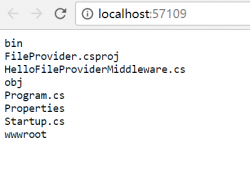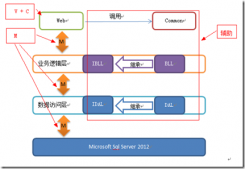1、前言
为什么我们要隐藏部分接口?
因为我们在用swagger代替接口的时候,难免有些接口会直观的暴露出来,比如我们结合Consul一起使用的时候,会将健康检查接口以及报警通知接口暴露出来,这些接口有时候会出于方便考虑,没有进行加密,这个时候我们就需要把接口隐藏起来,只有内部的开发者知道。
为什么要分组?
通常当我们写前后端分离的项目的时候,难免会遇到编写很多接口供前端页面进行调用,当接口达到几百个的时候就需要区分哪些是框架接口,哪些是业务接口,这时候给swaggerUI的接口分组是个不错的选择。

swagger的基本使用这里将不再赘述,可以阅读微软官方文档,即可基本使用
2、swaggerUI中加入授权请求
新建HttpHeaderOperationFilter操作过滤器,继承Swashbuckle.AspNetCore.SwaggerGen.IOperationFilter接口,实现Apply方法
|
1
2
3
4
5
6
7
8
9
10
11
12
13
14
15
16
17
18
19
20
21
22
23
24
25
26
27
28
29
30
31
32
33
34
35
36
37
38
39
40
41
42
43
44
45
46
47
48
49
50
51
52
53
54
55
56
57
|
/// <summary>/// swagger请求头/// </summary>public class HttpHeaderOperationFilter : IOperationFilter{ public void Apply(Operation operation, OperationFilterContext context) { #region 新方法 if (operation.Parameters == null) { operation.Parameters = new List<IParameter>(); } if (context.ApiDescription.TryGetMethodInfo(out MethodInfo methodInfo)) { if (!methodInfo.CustomAttributes.Any(t => t.AttributeType == typeof(AllowAnonymousAttribute)) &&!(methodInfo.ReflectedType.CustomAttributes.Any(t => t.AttributeType == typeof(AuthorizeAttribute)))) { operation.Parameters.Add(new NonBodyParameter { Name = "Authorization", In = "header", Type = "string", Required = true, Description = "请输入Token,格式为bearer XXX" }); } } #endregion #region 已过时 //if (operation.Parameters == null) //{ // operation.Parameters = new List<IParameter>(); //} //var actionAttrs = context.ApiDescription.ActionAttributes().ToList(); //var isAuthorized = actionAttrs.Any(a => a.GetType() == typeof(AuthorizeAttribute)); //if (isAuthorized == false) //{ // var controllerAttrs = context.ApiDescription.ControllerAttributes(); // isAuthorized = controllerAttrs.Any(a => a.GetType() == typeof(AuthorizeAttribute)); //} //var isAllowAnonymous = actionAttrs.Any(a => a.GetType() == typeof(AllowAnonymousAttribute)); //if (isAuthorized && isAllowAnonymous == false) //{ // operation.Parameters.Add(new NonBodyParameter // { // Name = "Authorization", // In = "header", // Type = "string", // Required = true, // Description = "请输入Token,格式为bearer XXX" // }); //} #endregion }} |
然后修改Startup.cs中的ConfigureServices方法,添加我们自定义的HttpHeaderOperationFilter过滤器
|
1
2
3
4
5
6
7
8
9
10
|
public IServiceProvider ConfigureServices(IServiceCollection services){ ... services.AddSwaggerGen(c => { ... c.OperationFilter<HttpHeaderOperationFilter>(); }); ...} |
这时候我们再访问swaggerUI就可以输入Token了
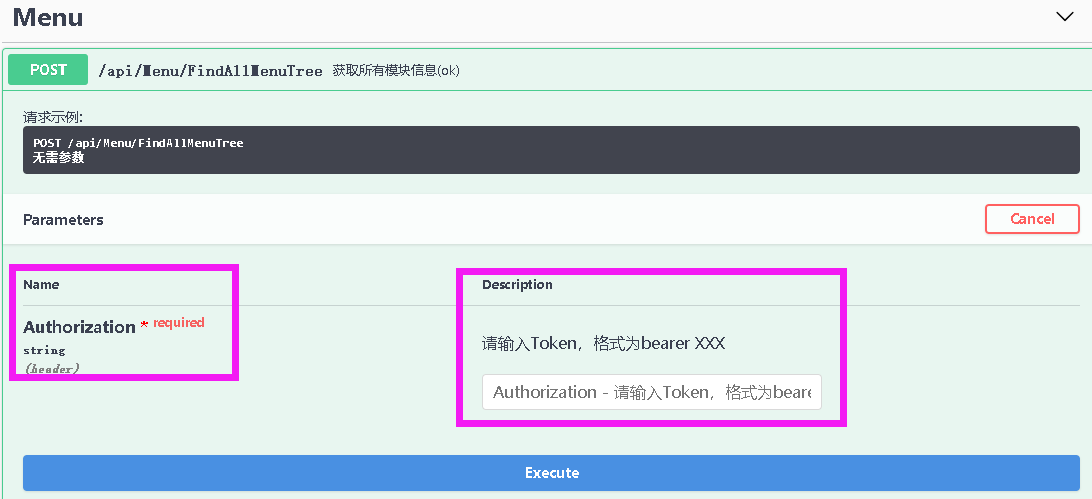
3、API分组
修改Startup.cs中的ConfigureServices方法,添加多个swagger文档
|
1
2
3
4
5
6
7
8
9
10
11
12
13
14
15
16
17
18
19
20
21
22
23
24
25
26
27
28
29
30
31
32
33
34
35
36
37
38
39
40
41
42
43
44
|
public IServiceProvider ConfigureServices(IServiceCollection services){ ... services.AddSwaggerGen(c => { c.SwaggerDoc("v1", new Info { Version = "v1", Title = "接口文档", Description = "接口文档-基础", TermsOfService = "", Contact = new Contact { Name = "XXX1111", Email = "XXX1111@qq.com", Url = "" } }); c.SwaggerDoc("v2", new Info { Version = "v2", Title = "接口文档", Description = "接口文档-基础", TermsOfService = "", Contact = new Contact { Name = "XXX2222", Email = "XXX2222@qq.com", Url = "" } }); //反射注入全部程序集说明 GetAllAssemblies().Where(t => t.CodeBase.EndsWith("Controller.dll")).ToList().ForEach(assembly => { c.IncludeXmlComments(assembly.CodeBase.Replace(".dll", ".xml")); }); c.OperationFilter<HttpHeaderOperationFilter>(); //c.DocumentFilter<HiddenApiFilter>(); }); ...} |
修改Startup.cs中的Configure方法,加入
|
1
2
3
4
5
6
7
8
9
10
11
12
13
|
public void Configure(IApplicationBuilder app, ILoggerFactory loggerFactory){ ... app.UseSwagger(); app.UseSwaggerUI(c => { c.SwaggerEndpoint("/swagger/v2/swagger.json", "接口文档-基础");//业务接口文档首先显示 c.SwaggerEndpoint("/swagger/v1/swagger.json", "接口文档-业务");//基础接口文档放后面后显示 c.RoutePrefix = string.Empty;//设置后直接输入IP就可以进入接口文档 }); ...} |
然后还要在我们的控制器上面标注swagger文档的版本
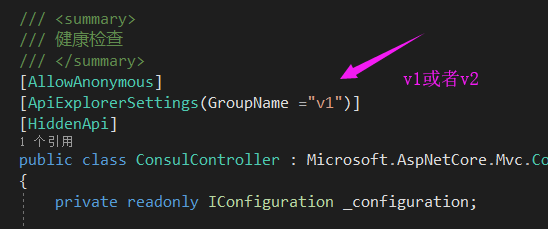
这时候我们就可以将接口文档进行分组显示了

4、API隐藏
创建自定义隐藏特性HiddenApiAttribute.cs
|
1
2
3
4
5
6
7
|
/// <summary>/// 隐藏swagger接口特性标识/// </summary>[AttributeUsage(AttributeTargets.Method | AttributeTargets.Class)]public class HiddenApiAttribute:System.Attribute{} |
创建API隐藏过滤器HiddenApiFilter继承Swashbuckle.AspNetCore.SwaggerGen.IDocumentFilter接口,实现Apply方法
|
1
2
3
4
5
6
7
8
9
10
11
12
13
14
15
16
17
18
19
20
21
22
23
24
25
26
|
/// <summary>/// 自定义Swagger隐藏过滤器/// </summary>public class HiddenApiFilter : IDocumentFilter{ public void Apply(SwaggerDocument swaggerDoc, DocumentFilterContext context) { foreach (ApiDescription apiDescription in context.ApiDescriptions) { if (apiDescription.TryGetMethodInfo(out MethodInfo method)) { if (method.ReflectedType.CustomAttributes.Any(t=>t.AttributeType==typeof(HiddenApiAttribute)) || method.CustomAttributes.Any(t => t.AttributeType == typeof(HiddenApiAttribute))) { string key = "/" + apiDescription.RelativePath; if (key.Contains("?")) { int idx = key.IndexOf("?", System.StringComparison.Ordinal); key = key.Substring(0, idx); } swaggerDoc.Paths.Remove(key); } } } }} |
在Startup.cs中使用HiddenApiFilter
|
1
2
3
4
5
6
7
8
9
10
11
12
13
14
15
16
17
18
19
20
21
22
23
24
25
26
27
28
29
30
31
32
33
34
35
36
37
38
39
40
41
42
43
44
45
|
public IServiceProvider ConfigureServices(IServiceCollection services){ ... services.AddSwaggerGen(c => { c.SwaggerDoc("v1", new Info { Version = "v1", Title = "接口文档", Description = "接口文档-基础", TermsOfService = "", Contact = new Contact { Name = "XXX1111", Email = "XXX1111@qq.com", Url = "" } }); c.SwaggerDoc("v2", new Info { Version = "v2", Title = "接口文档", Description = "接口文档-基础", TermsOfService = "", Contact = new Contact { Name = "XXX2222", Email = "XXX2222@qq.com", Url = "" } }); //反射注入全部程序集说明 GetAllAssemblies().Where(t => t.CodeBase.EndsWith("Controller.dll") && !t.CodeBase.Contains("Common.Controller.dll")).ToList().ForEach(assembly => { c.IncludeXmlComments(assembly.CodeBase.Replace(".dll", ".xml")); }); c.OperationFilter<HttpHeaderOperationFilter>(); c.DocumentFilter<HiddenApiFilter>(); }); ...} |
示例:
我这里提供了Consul的心跳检车接口
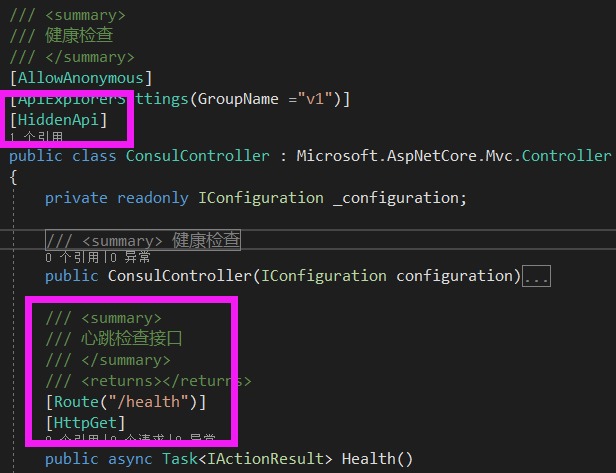
但是在接口文档中并没有显示出来
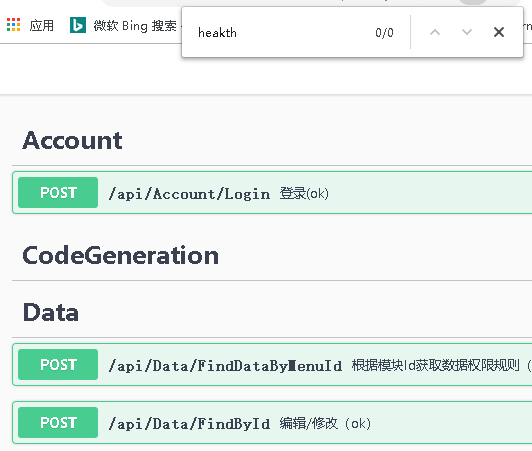
总结
以上就是这篇文章的全部内容了,希望本文的内容对大家的学习或者工作具有一定的参考学习价值,谢谢大家对服务器之家的支持。
原文链接:http://www.cnblogs.com/wyt007/p/10650974.html


